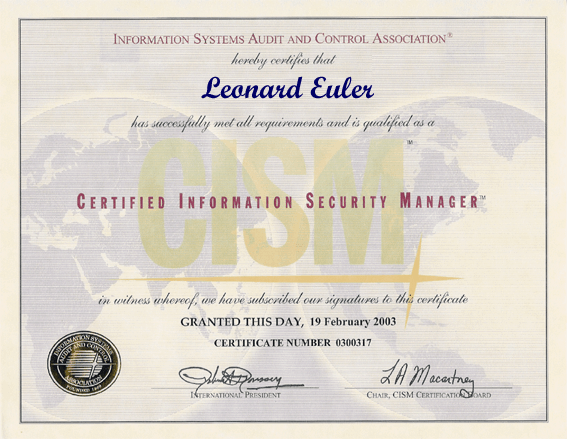- Domain 1 – Information Security Governance (24%)
Establish and maintain an information security governance framework and supporting processes to ensure that the information security strategy is aligned with organizational goals and objectives, information risk is managed appropriately and program resources are managed responsibly.
Tasks- Establish and maintain an information security strategy in alignment with organizational goals and objectives to guide the establishment and ongoing management of the information security program.
- Establish and maintain an information security governance framework to guide activities that support the information security strategy.
- Integrate information security governance into corporate governance to ensure that organizational goals and objectives are supported by the information security program.
- Establish and maintain information security policies to communicate management’s directives and guide the development of standards, procedures and guidelines.
- Develop business cases to support investments in information security.
- Identify internal and external influences to the organization (for example, technology, business environment, risk tolerance, geographic location, legal and regulatory requirements) to ensure that these factors are addressed by the information security strategy.
- Obtain commitment from senior management and support from other stakeholders to maximize the probability of successful implementation of the information security strategy.
- Define and communicate the roles and responsibilities of information security throughout the organization to establish clear accountabilities and lines of authority.
- Establish, monitor, evaluate and report metrics (for example, key goal indicators [KGIs], key performance indicators [KPIs], key risk indicators [KRIs]) to provide management with accurate information regarding the effectiveness of the information security strategy.
- Knowledge of methods to develop an information security strategy
- Knowledge of the relationship among information security and business goals, objectives, functions, processes and practices
- Knowledge of methods to implement an information security governance framework
- Knowledge of the fundamental concepts of governance and how they relate to information security
- Knowledge of methods to integrate information security governance into corporate governance
- Knowledge of internationally recognized standards, frameworks and best practices related to information security governance and strategy development
- Knowledge of methods to develop information security policies
- Knowledge of methods to develop business cases
- Knowledge of strategic budgetary planning and reporting methods
- Knowledge of the internal and external influences to the organization (for example, technology, business environment, risk tolerance, geographic location, legal and regulatory requirements) and how they impact the information security strategy
- Knowledge of methods to obtain commitment from senior management and support from other stakeholders for information security
- Knowledge of information security management roles and responsibilities
- Knowledge of organizational structures and lines of authority
- Knowledge of methods to establish new, or utilize existing, reporting and communication channels throughout an organization
- Knowledge of methods to select, implement and interpret metrics (for example, key goal indicators [KGIs], key performance indicators [KPIs], key risk indicators [KRIs])
- Domain 2 – Information Risk Management and Compliance (33%)
Manage information risk to an acceptable level to meet the business and compliance requirements of the organization.
Tasks- Establish and maintain a process for information asset classification to ensure that measures taken to protect assets are proportional to their business value.
- Identify legal, regulatory, organizational and other applicable requirements to manage the risk of noncompliance to acceptable levels.
- Ensure that risk assessments, vulnerability assessments and threat analyses are conducted periodically and consistently to identify risk to the organization’s information.
- Determine appropriate risk treatment options to manage risk to acceptable levels.
- Evaluate information security controls to determine whether they are appropriate and effectively mitigate risk to an acceptable level.
- Identify the gap between current and desired risk levels to manage risk to an acceptable level.
- Integrate information risk management into business and IT processes (for example, development, procurement, project management, mergers and acquisitions) to promote a consistent and comprehensive information risk management process across the organization.
- Monitor existing risk to ensure that changes are identified and managed appropriately.
- Report noncompliance and other changes in information risk to appropriate management to assist in the risk management decision-making process.
- Knowledge of methods to establish an information asset classification model consistent with business objectives
- Knowledge of methods used to assign the responsibilities for and ownership of information assets and risk
- Knowledge of methods to evaluate the impact of adverse events on the business
- Knowledge of information asset valuation methodologies
- Knowledge of legal, regulatory, organizational and other requirements related to information security
- Knowledge of reputable, reliable and timely sources of information regarding emerging information security threats and vulnerabilities
- Knowledge of events that may require risk reassessments and changes to information security program elements
- Knowledge of information threats, vulnerabilities and exposures and their evolving nature
- Knowledge of risk assessment and analysis methodologies
- Knowledge of methods used to prioritize risk
- Knowledge of risk reporting requirements (for example, frequency, audience, components)
- Knowledge of methods used to monitor risk
- Knowledge of risk treatment strategies and methods to apply them
- Knowledge of control baseline modeling and its relationship to risk-based assessments
- Knowledge of information security controls and countermeasures and the methods to analyze their effectiveness and efficiency
- Knowledge of gap analysis techniques as related to information security
- Knowledge of techniques for integrating risk management into business and IT processes
- Knowledge of compliance reporting processes and requirements
- Knowledge of cost/benefit analysis to assess risk treatment options
- Domain 3 – Information Security Program Development and Management (25%)
Establish and manage the information security program in alignment with the information security strategy.
Tasks- Establish and maintain the information security program in alignment with the information security strategy.
- Ensure alignment between the information security program and other business functions (for example, human resources [HR], accounting, procurement and IT) to support integration with business processes.
- Identify, acquire, manage and define requirements for internal and external resources to execute the information security program.
- Establish and maintain information security architectures (people, process, technology) to execute the information security program.
- Establish, communicate and maintain organizational information security standards, procedures, guidelines and other documentation to support and guide compliance with information security policies.
- Establish and maintain a program for information security awareness and training to promote a secure environment and an effective security culture.
- Integrate information security requirements into organizational processes (for example, change control, mergers and acquisitions, development, business continuity, disaster recovery) to maintain the organization’s security baseline.
- Integrate information security requirements into contracts and activities of third parties (for example, joint ventures, outsourced providers, business partners, customers) to maintain the organization’s security baseline.
- Establish, monitor and periodically report program management and operational metrics to evaluate the effectiveness and efficiency of the information security program.
- Knowledge of methods to align information security program requirements with those of other business functions
- Knowledge of methods to identify, acquire, manage and define requirements for internal and external resources
- Knowledge of information security technologies, emerging trends, (for example, cloud computing, mobile computing) and underlying concepts
- Knowledge of methods to design information security controls
- Knowledge of information security architectures (for example, people, process, technology) and methods to apply them
- Knowledge of methods to develop information security standards, procedures and guidelines
- Knowledge of methods to implement and communicate information security policies, standards, procedures and guidelines
- Knowledge of methods to establish and maintain effective information security awareness and training programs
- Knowledge of methods to integrate information security requirements into organizational processes
- Knowledge of methods to incorporate information security requirements into contracts and third-party management processes
- Knowledge of methods to design, implement and report operational information security metrics
- Knowledge of methods for testing the effectiveness and applicability of information security controls
- Domain 4 – Information Security Incident Management (18%)
Plan, establish and manage the capability to detect, investigate, respond to and recover from information security incidents to minimize business impact.
Tasks- Establish and maintain an organizational definition of, and severity hierarchy for, information security incidents to allow accurate identification of and response to incidents.
- Establish and maintain an incident response plan to ensure an effective and timely response to information security incidents.
- Develop and implement processes to ensure the timely identification of information security incidents.
- Establish and maintain processes to investigate and document information security incidents to be able to respond appropriately and determine their causes while adhering to legal, regulatory and organizational requirements.
- Establish and maintain incident escalation and notification processes to ensure that the appropriate stakeholders are involved in incident response management.
- Organize, train and equip teams to effectively respond to information security incidents in a timely manner.
- Test and review the incident response plan periodically to ensure an effective response to information security incidents and to improve response capabilities.
- Establish and maintain communication plans and processes to manage communication with internal and external entities.
- Conduct postincident reviews to determine the root cause of information security incidents, develop corrective actions, reassess risk, evaluate response effectiveness and take appropriate remedial actions.
- Establish and maintain integration among the incident response plan, disaster recovery plan and business continuity plan.
- Knowledge of the components of an incident response plan
- Knowledge of incident management concepts and practices
- Knowledge of business continuity planning (BCP) and disaster recovery planning (DRP) and their relationship to the incident response plan
- Knowledge of incident classification methods
- Knowledge of damage containment methods
- Knowledge of notification and escalation processes
- Knowledge of the roles and responsibilities in identifying and managing information security incidents
- Knowledge of the types and sources of tools and equipment required to adequately equip incident response teams
- Knowledge of forensic requirements and capabilities for collecting, preserving and presenting evidence (for example, admissibility, quality and completeness of evidence, chain of custody)
- Knowledge of internal and external incident reporting requirements and procedures
- Knowledge of postincident review practices and investigative methods to identify root causes and determine corrective actions
- Knowledge of techniques to quantify damages, costs and other business impacts arising from information security incidents
- Knowledge of technologies and processes that detect, log and analyze information security events
- Knowledge of internal and external resources available to investigate information security incidents
- Exam preparation
- Preparation Strategy
- Examinations white
Sécurité des systèmes d’information, certification CISM
Gouvernance, sécurité, audit
Home » ISEIG Cours » Sécurité des systèmes d’information, certification CISM
Introduction
La certification CISM (Certified Information Security Manager) offre la possibilité aux gestionnaires de la sécurité IT de prouver leurs connaissances et de démontrer leur expertise par un certificat unique défini par l'ISACA - Information Systems Audit and Control Association.
Cette certification s'adresse aux responsables de la sécurité des systèmes d'information et aux consultants en sécurité désireux de démontrer leurs expériences et compétences dans le domaine de la sécurité. Elle se différencie des autres certifications sécurité existantes par le fait qu'il s'agit d'une certification sur le management de la sécurité des systèmes d'information et non sur des compétences strictement techniques. Elle sanctionne à la fois :
Cette certification s'adresse aux responsables de la sécurité des systèmes d'information et aux consultants en sécurité désireux de démontrer leurs expériences et compétences dans le domaine de la sécurité. Elle se différencie des autres certifications sécurité existantes par le fait qu'il s'agit d'une certification sur le management de la sécurité des systèmes d'information et non sur des compétences strictement techniques. Elle sanctionne à la fois :
- la réussite de l'examen CISM (150 questions à choix multiple en 4 heures, données 2024). Cet examen peut être passé par des candidats sans ou avec peu d'expérience.
- et la validation de 5 années d'expérience dans le domaine. Cette validation se fait sur la base d'un dossier à envoyer à l'ISACA. Le candidat a 5 ans à compter de la réussite de l'examen pour faire une demande de certification d'expérience.

La matière couverte par le CISM est continuellement actualisée pour répondre aux exigences en constante évolution. Elle est structurée dans les 4 domaines suivants :
Documentation pdf ...
- gouvernance de la sécurité de l'information
- gestion des risques et de la conformité des informations
- développement et gestion de programmes de sécurité de l'information
- gestion des incidents de sécurité de l'information.
- d'acquérir, compléter et systématiser ses connaissances méthodologiques dans le domaine de la gouvernance de la sécurité des systèmes d'information
- de se préparer à la certification internationale CISM - Certified Information Security Manager.
- la gouvernance de la sécurité
- le management des risques
- le développement d'un programme de mise en place de la sécurité des systèmes d'information
- la gestion de la sécurité
- la gestion des incidents.
- vous exercez dans le management de la sécurité des systèmes d’information (SI)
- vous avez de l’expérience dans les domaines liés à la gestion des incidents, au développement et à la gestion de programmes de sécurité, à la gestion des risques
- vous exercez dans l’informatique et souhaitez acquérir les connaissances pour participer activement au management de la sécurité des SI
- vous souhaitez être reconnu pour votre expertise.
Documentation pdf ...
Prix, Dates, Inscription
La formation se déroule 2 fois par année à raison d'un jour par semaine. Les cours se déroulent généralement de 9h00 à 12h00 et de 13h30 à 17h00.
Sécurité des systèmes d’information, certification CISM
Durée
4
Prix
CHF 3'000.-
Prix/j.
CHF 750.-
Cycle 1
8, 9 avr, 4, 5 mai 2026
Sécurité des systèmes d’information, certification CISM
Durée
4
Prix
CHF 3'000.-
Prix/j.
CHF 750.-
Cycle 2
7, 8 avr, 3, 4 mai 2027
Le prix du cours comprend toute la documentation pédagogique distribuée qui comprend des ouvrages, les supports de cours et supports de présentation, exercices avec corrigés et examens à blanc avec corrigés.
Le prix de l'examen, non compris, s'élève à USD 575.- pour membre de l'ISACA ou USD 760.- pour non membre (tarifs 2024).
Selon notre expérience, la réussite des examens implique en plus du cours et des exercices dirigés, un travail personnel d´assimilation conséquent dont la charge est estimée à 2 jours par jour de cours suivi.
Le prix de l'examen, non compris, s'élève à USD 575.- pour membre de l'ISACA ou USD 760.- pour non membre (tarifs 2024).
Selon notre expérience, la réussite des examens implique en plus du cours et des exercices dirigés, un travail personnel d´assimilation conséquent dont la charge est estimée à 2 jours par jour de cours suivi.
Programme détaillé
Les 4 domaines de connaissances suivants sont présentés dans ce cours :
- gouvernance de la sécurité de l'information
- gestion des risques et de la conformité des informations
- développement et gestion de programmes de sécurité de l'information
- gestion des incidents de sécurité de l'information.
Pour qui
- professionnel de la sécurité IT souhaitant valider ses connaissances et compétences
- spécialiste de la sécurité IT junior souhaitant acquérir les connaissances pour participer activement à des projets de management de la sécurité IT
- toute personne ayant l'intérêt et la volonté de se spécialiser dans le management de la sécurité des systèmes d'information, comme par exemple : informaticien, chef de projet ou gestionnaire confronté aux aspects de risques, contrôles et sécurité des systèmes d'information souhaitant compléter et faire reconnaître ses compétences dans le management de la sécurité des systèmes d'information
Objectifs
- connaître le modèle de la gouvernance de la sécurité IT proposé par l'ISACA
- savoir aligner la stratégie de sécurité des informations aux objectifs métier de l’entreprise et s’assurer qu’elle répond aux exigences des lois et réglementations
- savoir concevoir, mettre en place et maintenir un système pour assurer la sécurité des informations
- savoir identifier et gérer les risques liés à la sécurité des informations pour assurer les objectifs métiers
- savoir créer et gérer un programme pour mettre en place une stratégie de sécurité des informations
- savoir superviser et diriger les activités liées à la sécurité dans l’application du programme de sécurité des informations
- s'entraîner au déroulement de l'examen de certification
- acquérir les stratégies de réponse au questionnaire
Prérequis
- connaissances de base de l'informatique (processus, technologie, organisation)
- connaissances des processus de gouvernance d'entreprise
- tout candidat peut se présenter à l'examen mais n'obtiendra la certification que lorsqu'il aura réussi l'examen et pourra justifier de 3 ou 5 années d'expérience dans la sécurité des SI selon les règles définies par l'ISACA (voir www.isaca.org)
- bonnes connaissances de l'anglais technique écrit, une partie des documents de cours et les questions d'examen étant en anglais
- le candidat est prêt à investir du temps de préparation entre les sessions de formation (révision / questions d'examen)





